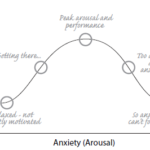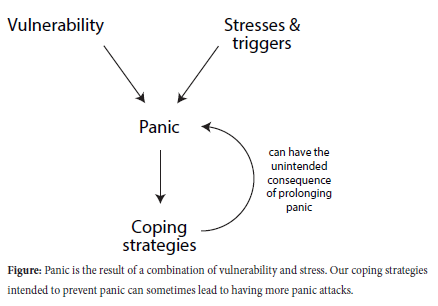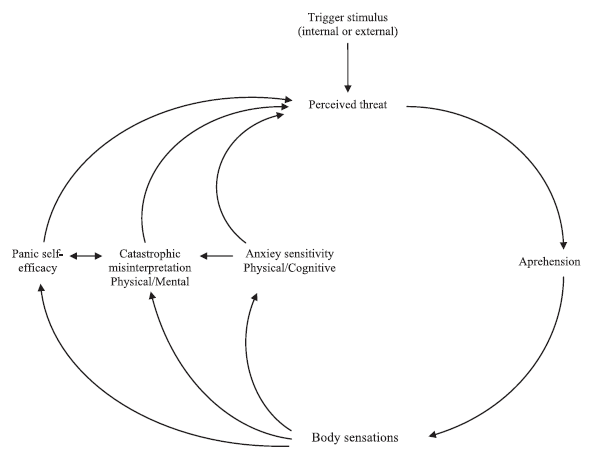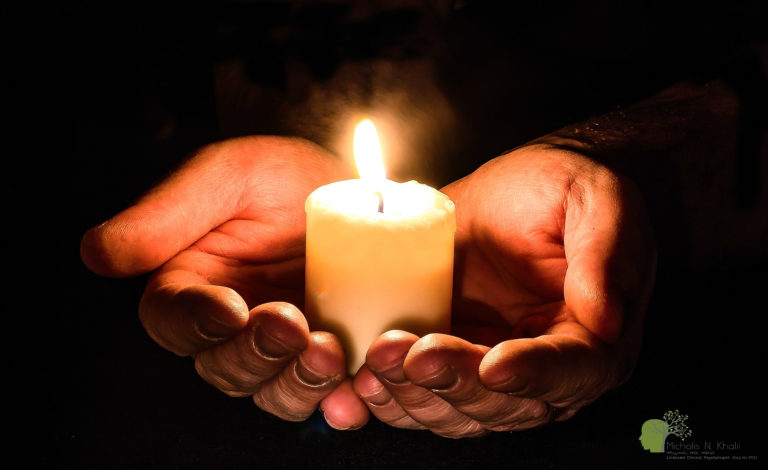
In this article I will present very briefly some facts about Panic Disorder. Don’t panic, it won’t take long! I’ll try to keep it brief and simple.
To begin with some facts. Did you know that 1 in every 4 people experiences panic attack at some point in their life? (1) That’s quite a deal isn’t it? A quarter of people in a population faces sudden and repeated attacks of fear, accompanied with intense physical sensations such as a racing heartbeat, sweating, shaking, and thoughts that something horrible is about to happen. The sneaky part of panic is that they can happen anytime – yes, even when you are cruising with your car or while going through your ex’s pics on Facebook! This leads people to dread the possibility of having another panic attack, giving them no choice but to take steps to prevent this from happening i.e. staying at home and isolate themselves from the world. That is why sometimes panic attack comes hand-in-hand with agoraphobia.
According to the Diagnostic and Statistical Manual of the American Psychological Association, panic attacks are a sudden surge of intense fear or discomfort that reaches a peak within seconds to minutes. Panic attacks involve feeling at least four of the following symptoms:
• Palpitations, pounding heart, or accelerated heart rate
• Sweating
• Trembling or shaking
• Sensations of shortness of breath or smothering
• Feeling of choking
• Chest pain or discomfort
• Nausea or abdominal distress (e.g. diarrhea)
• Feeling dizzy, unsteady, lightheaded, or faint
• Chills or heat sensations
• Paresthesias (numbness or tingling sensations)
• Derealization (feelings of unreality) or depersonalization (feeling of being detached from oneself)
• Fear of losing control or going crazy
• Fear of dying
However, a mental health professional must always instruct a physical check to rule out any physical causes for the above-stated symptoms. Sometimes one could have one panic attack and never experience another. However, this is rarely the case.
How much stress is good for you?
Before rushing to disapprove stress, we should understand that some stress is good for us if kept in moderation. It is an agent of action. Think about the stream locomotive back in the day. These locomotives were fueled by burning combustible material – usually coal, wood, or oil – to produce steam in a boiler. Now, too much pressure in this boiler might break the engine, too less pressure and there is no pull. Something similar is going on with our anxiety. Whalley (2017) created a graph that is spot-on to the point: Too much anxiety leads to very low performance and consequently to panic; too less anxiety then hell – no need to get out of the bed!

What is the difference between a Panic Disorder and a Panic Attack?
Panic Attacks
- Panic attacks are single episodes of intense fear and are common especially in people who suffer form anxiety disorders.
- Unpleasant in the short-term but pass quite quickly
Panic disorder
- Panic disorder exists when people have more than one sudden and unexpected panic attack
- Worry a lot about the chance of having another one
- Take steps to avoid another panic attack such as not going in places where a previous panic attack has happened
- People with panic disorder even when they are not panicking, they tend to worry about the possibility of another attack
Causes
Many things can cause panic. There are some things that make people vulnerable to developing panic as some point. This vulnerability is enhanced by specific stresses and triggers. After panic develops, typically people engage in some common things to cope with the negative feelings panic brings. However, despite the short-term benefits of those strategies, there are unintended consequences in the long run, which result in recurrent panic attacks.

What are the vulnerability factors of panic?
A combination of biological and psychological factors could lead a person to develop vulnerability to panic (1). People must know that there is not something wrong with people who experience panic. It is not the result of a neurochemical imbalance nor any major biological dysfunction. It is not hereditary like color or height (1). It is, however, shown with clear evidence the heritability of “trait anxiety”, “neuroticism”, or “negative affect” (6). Thus, although there is a genetic component to stress, it doesn’t mean that it causes panic or anxiety directly. It most possibly means that it may create the appropriate conditions for the occurrence of anxiety or panic, or both in people who are under stress (6).
Each individual has a different nervous system, and those who are more vulnerable to panic are thought to have more sensitive nervous systems. In other words, they keep vigilant – more than the average person – on what is going on with their bodies, thus keeping them in high alert of their bodily reactions.
Many psychological factors have a role to play. Thoughts affects the way we are feeling. Therefore, strong beliefs about something leads to a certain feeling. For example, if you have a certain belief about a physical sensation, sooner or later you will develop high sensitivity about it. A tightness in your throat doesn’t mean that you will suffocate, neither does a racing heart mean that you will have a heart attack. If your fixed belief is that a particular body sensation is harmful, then you have no choice but to put yourself under unnecessary stress. Our personal experience shape and develop our beliefs.
What triggers panic attacks?
First and foremost, stress is an important contributor to panic attacks. Many things can elicit distress, such as relationship problems, work difficulties, financial problems, health issues. Milder stressful events such as starting a new job or going on a date after many years of being in the “game” has stressful results as well. But we must bear in mind that every person responds differently to stress i.e. what is highly stressful for a person may not be the same for somebody else.
Generally being outside of our comfort zone has the capacity to elicit distress. If we are already under a lot of distress, we are more likely to experience panic. Stress has the ability to accumulate, unless we do something to relieve ourselves from this. The following diagram explains it clearly:

It seems that not only having stress as a trait influences the development of panic disorder but having sensitivity to anxiety (i.e. fear of fear) also contributes to panic disorder. It has been shown by research that anxiety sensitivity could lead to symptoms of a panic disorder (2). In addition to anxiety sensitivity, catastrophic misinterpretation of bodily sensations and panic self-efficacy where shown as significant factors towards panic disorder. This led to the development of a tripartite cognitive model of panic disorder (2). Essentially, Anxiety Sensitivity, in addition of catastrophic misinterpretations and panic self-efficacy contributes independently to the severity of panic (see following figure).

What treatment is available?
It has been suggested that applied relaxation, exposure techniques, and variants of Cognitive Behavioural Therapy (CBT) are the treatments of choice for Panic Disorder (1). Even that medications could be used to treat Panic disorder (SSRIs, tricyclics, or benzodiazepines), studies have shown that cognitive and behavioural interventions produce better and longer results (3). Some additional mechanisms of change during therapy could be changes in self-efficacy and anxiety sensitivity, which could have a positive impact in the overall treatment of panic disorder (4).
Although one could use self-help material to fight panic disorder (1), a guided self-help by a mental health professional is the best method of treatment (5). Therefore, if you catch yourself or somebody around you who is an anxious individual and faces the struggle of panic disorder, kindly ask them to refer to a counseling or clinical psychologist for help. Remember, medication alone does not do the trick! You need to put down the effort with the help of a therapist.
The following YouTube video summarizes in a graphic way the main concepts I have presented about Panic Disorder.
References
1. Whalley, Matthew. Psychology Tools for Overcoming Panic. s.l. : Psychology Tools, 2017. 978-0-9932968-4-0.
2. Anxiety sensitivity, catastrophic misinterpretations and panic self-efficacy in the prediction of panic disorder severity: Towards a tripartite cognitive model of panic disorder. Sandin, B., et al. 2015, Behaviour Research and Therapy, Vol. 67, pp. 30-40.
3. Roth, Anthony and Fonagy, Peter. Chapter 6. Anxiety Disorders I. Specific Phobia, Social Phobia, Generlized Anxiety Disorder, and Panic Disorder with and without Agoraphobia. What Works for Whom? Second Edition. A Critical Review of Psychotherapy Research. New York : The Guildford Press, 2005, pp. 150-195.
4. Mechanisms of change in cognitive behavioral therapy for panic disorder: the unique effects of self-efficacy and anxiety sensitivity. Gallagher, M. W., et al. 11, 2013, Behaviour research and therapy, Vol. 51, pp. 767-777.
5. Internet-based treatment for panic disorder: A three-arm randomized controlled trial comparing guided (via real-time video sessions) with unguided self-help treatment and a waitlist control. Ciuca, A. M., et al. s.l. : Journal of anxiety disorders , 2018, Vol. 56, pp. 43-55.
6. A modern learning theory perspective on the etiology of panic disorder. Bouton, M. E., Mineka, S. and Barlow, D. H. 1, 2001, Psychological review, Vol. 108, pp. 4-32.



